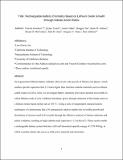Rechargeable-battery chemistry based on lithium oxide growth through nitrate anion redox
Author(s)
Gallant, Betar M. (Betar Maurkah)
DownloadAccepted version (184.4Kb)
Publisher Policy
Publisher Policy
Article is made available in accordance with the publisher's policy and may be subject to US copyright law. Please refer to the publisher's site for terms of use.
Terms of use
Metadata
Show full item recordAbstract
Next-generation lithium-battery cathodes often involve the growth of lithium-rich phases, which enable specific capacities that are 2−3 times higher than insertion cathode materials, such as lithium cobalt oxide. Here, we investigated battery chemistry previously deemed irreversible in which lithium oxide, a lithium-rich phase, grows through the reduction of the nitrate anion in a lithium nitrate-based molten salt at 150 °C. Using a suite of independent characterization techniques, we demonstrated that a Ni nanoparticle catalyst enables the reversible growth and dissolution of micrometre-sized lithium oxide crystals through the effective catalysis of nitrate reduction and nitrite oxidation, which results in high cathode areal capacities (~12 mAh cm–2). These results enable a rechargeable battery system that has a full-cell theoretical specific energy of 1,579 Wh kg–1, in which a molten nitrate salt serves as both an active material and the electrolyte.
Date issued
2019-10Department
Massachusetts Institute of Technology. Department of Mechanical EngineeringJournal
Nature Chemistry
Publisher
Springer Science and Business Media LLC
Citation
Giordani, Vincent et al. “Rechargeable-battery chemistry based on lithium oxide growth through nitrate anion redox.” Nature Chemistry, 11, 12 (October 2019): 1133–1138 © 2019 The Author(s)
Version: Author's final manuscript
ISSN
1755-4349
1755-4330